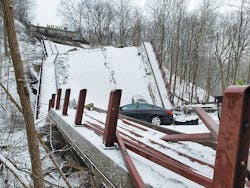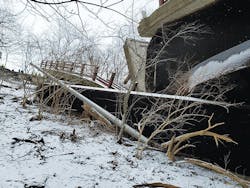Looking for answers after Pittsburgh’s bridge collapse
Jane Dudley lives near Frick Park in Pittsburgh. On Jan. 28, shortly after 6:30 a.m., she went outside to shovel the snow that had covered her sidewalk overnight.
Later, she would tell ABC News that she heard “a loud boom” followed by “a roar” sound.
As Dudley rushed back inside her house to go online and figure out what was happening, 911 dispatchers began receiving calls from people who witnessed the Fern Hollow Bridge collapse. One dispatcher told first responders there was “a lot of screaming and static on the phone.”
Fortunately, no one died. However, 10 people were injured when the Fern Hollow Bridge—a 497-ft, K-frame structure—fell into the ravine in Frick Park. The “roar” sound Dudley heard was a gas leak caused by the collapse, and it was quickly shut off.
Built in 1973, the bridge was part of Forbes Avenue, one of Pittsburgh’s most-traveled roads, and it was a mile from an I-376 exit, with Regent Square’s popular business district in between. Before the pandemic, the bridge carried about 14,000 vehicles a day.
The National Transportation Safety Board is investigating what caused the collapse. Its final report will not be finished for more than a year, but a preliminary report was released last month. It stated that the collapse began at the west end of the bridge, which was in the neighborhood of Squirrel Hill.
Each end of the bridge rested on reinforced concrete caps on stone masonry abutments, and the girders were also supported by welded steel frame legs. “Although certain areas of the welded steel girders were identified as being fracture critical, no primary fractures were found in these areas,” according to the report.
The NTSB recovered video from a Port Authority bus that was headed east on the bridge when it collapsed. The bus had five interior cameras. The NTSB also has announced that its investigation will include a forensic examination of the Fern Hollow Bridge’s structural components.
Ironically, President Biden was already scheduled to visit Pittsburgh that day to deliver a speech about the importance of the Infrastructure Investment and Jobs Act (IIJA), which he signed into law in November with bipartisan support.
The coincidence of the visit, along with the fact that the bridge was graded as being in poor condition during its last inspection, has garnered national attention.
With the spotlight on them in the wake of the bridge collapse, Pittsburgh and PennDOT officials have been working to calm the public about other bridges that are rated in poor condition—of which there are many around the city and throughout Pennsylvania—while also moving quickly to replace the fallen structure.
An emergency design contract will fast-track the reconstruction of a new bridge. The $25 million project was announced by PennDOT and Pennsylvania Gov. Tom Wolf. A reimbursement grant agreement allows PennDOT to build a new structure.
Swank Construction Company/HDR Inc. removed the rubble and will design the bridge.
Gov. Wolf signed a proclamation of disaster emergency for Allegheny County, where Pittsburgh is located. Acting on the request of Mayor Ed Gainey, Pittsburgh City Council also declared the collapse a disaster. Both declarations free up resources and move federal funds faster than usual.
Mayor Gainey and City Councilman Corey O’Connor presented legislation to form a commission to advise officials on the status and needs of area infrastructure.
The 17-member commission—made up of city officials, state officials, and representatives from organized labor and construction, as well as infrastructure experts—would serve as a watchdog for the city-maintained roads, bridges, and tunnels, and it would give recommendations.
“This allows our city’s Department of Mobility to get much-needed support from outside agencies that they don’t usually talk to every day,” O’Connor told Roads & Bridges. “It will also allow us on Council to take the recommendations and hopefully prioritize them.”
Another bill requires the city’s Department of Mobility and Infrastructure to provide regular, public update reports on the status of the city’s infrastructure. Security concerns prevent the city from being completely transparent.
“We’re trying to be as transparent as we can be with the public, who have a right to know this information,” said O’Connor, who played little league as a boy on the baseball field on the corner at the end of the Fern Hollow Bridge. “We’re not going to take any more risks. If a bridge should be closed in the future, it should be closed.”
PennDOT conducts 18,000 bridge inspections each year, which averages out to about 70 per day.
Pennsylvania has more than 25,000 bridges, and last year, by federal estimates, 3,353 of them were considered to be in poor condition. That is the second highest in the country. Only Iowa has more, with 4,571.
In 2008, there were over 6,000 state-owned bridges that were in poor condition in Pennsylvania. Today, that number has dropped. However, because of the age of its bridges, and the size of the commonwealth, 250 of its state-owned bridges move into that poor category each year, according to Acting Executive Deputy Secretary Melissa Batula.
“So we must preserve, repair, and replace at a greater rate each year to continue that trend of reducing the number of bridges that are in poor condition,” Batula said at a virtual press conference last month.
The IIJA should help Pennsylvania address its bridge problems. In January, U.S. Transportation Secretary Pete Buttigieg announced that Pennsylvania would receive $1.63 billion over five years, including $327 million in 2022, to improve bridges.
Learning from what exactly happened to the Fern Hollow Bridge will likely influence how Pittsburgh and Pennsylvania officials put this money to good use. In 2014, inspectors found enough problems with the bridge that it was inspected every year, and four years later, the city determined that a rusting and detached X-shaped bracing had become a safety risk, according to reporting from the Pittsburgh Post-Gazette.
The city removed the bracing and left steel cables as support in their place. The weight limit on the bridge was reduced from 36 tons to 26 tons.
Maria C. Lehman, American Society of Civil Engineers president-elect and Director of U.S. Infrastructure at GHD, told Roads & Bridges that the cables are a function of the bridge owner looking at the inspection and saying, “What do we do to make it stronger? Because it’s not performing as it should.”
Lehman noted that any kind of a slender steel bridge in the northeast that’s been around for a while sees a lot of weather and salt. She said that bridge owners are supposed to compensate for when you are looking at the inspections as far as what the concerns are.
“When they are doing those inspections, they do low gradings, and that’s how you come up with a posting,” she said. “So all that data has to come forward to understand what happened there.”
Lehman added: “Unfortunately, American infrastructure is not in a midlife crisis. It’s in an old-age crisis. Most of the infrastructure you see out there is serving us well beyond its design life. And it is serving us beyond what it was anticipated to when it was built. When you look at the weights of the trucks and how much weather they were going to take, it’s amazing things are working as well as they are.”
As soon as he learned of the collapse, Councilman O’Connor got in his car and drove to the intersection at the end of the bridge. He saw the people who had been pulled out of the ravine by first responders, and then he looked into the ravine at what was left of the bridge he had traveled over thousands of times.
“The shock was seeing it and just realizing that no one was severely injured,” he said.

